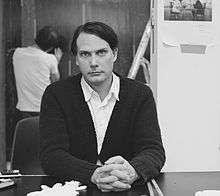Gregor Hildebrandt

Gregor Hildebrandt (born 1974 in Bad Homburg, West Germany) is a German contemporary artist who lives and works in Berlin, Germany
Early life and education
Gregor Hildebrandt graduated from Hochschule der Künste, Berlin in 2002, after he studied previously at the University of Mainz between 1995-1999. Hildebrandt was awarded a Studienstiftung scholarship between 1998-2002 and received a scholarship at the Deutsches Studienzentrum in Venice the following year, while still a student. Today, he lives in Berlin with fellow artist Alicja Kwade.
Work
In his artistic practice, Gregor Hildebrandt makes extensive use of pre-recorded cassette tapes as material in his pictures and installations. The tapes are applied directly onto canvases and photographic prints and in room-sized installations.[1] In his paintings, he adheres the coated side of cassette tapes onto a canvas, presses on it with a brush or roller, and rips the tape off to create the defined, yet sporadic lines on his works. He repeats the process before finally gluing them onto the canvas for good to create what he calls the “negative” painting.[2] For sculptures, he shapes vinyl records into bowls, sometimes stacking them to create what the artist calls a “sonic wall made of pillars of records.”[3]
Although Hildebrandt’s work makes formal reference to Minimalism, the addition of a great number of subjective and autobiographical citations actually deliberately repudiates this strategy. For Hildebrandt, the cassette tape as artistic medium, especially in its original function of storage medium, fulfils an important function: it enables the artist to add a further “invisible” dimension to his pictures. Playing with perception in this way is a major characteristic of his work; the picture is completed in the head of the viewer.
If the contemplation of his art incorporates the heterogeneous cosmos of Gregor Hildebrandt’s references to music, film, literature and, last but not least, art history, his works turn out to be complex montages, in which pictorial associations from different spheres combine and interpenetrate. Hildebrandt employs the material of his every-day environment without aesthetic or theoretical inhibition and playfully links aspects of conceptual art and minimal art with his personal life and experience of pop culture.
Gregor Hildebrandt is represented by Wentrup in Berlin, http://www.grimmgallery.com/artists/gregor-hildebrandt/ Grimm Gallery] in Amsterdam, Almine Rech Gallery in Paris, Brussels and London and Emmanuel Perrotin in New York.[2]
Selected Solo Exhibitions
2012
- Nächtliches Konzert, Museum Van Bommel van Dam with Jorinde Voigt, Venlo, Netherlands
- Eind Koffer aus Berlin, Saarländisches Künstlerhaus, Saarbrücken
- Schlaf is Zeit, die dir gehört, AVLSKARL, Copenhagen
2011
- FÜR KOMMENDE MORGEN, Wentrup, Berlin
- Seiten im Buch wie Wände im Raum, Almine Rech Gallery, Paris
- Und dass zu frühe die Parze den Traum nicht ende, Grimm Gallery, Amsterdam
2010
- vor der Tür stehen weiße Pferde, Galerie Almine Rech, Brussels
- die Nacht trägt den Plan, Van Horn, Düsseldorf
- Shapeless in the Dark again, Sommer Contemporary, Tel Aviv
2009
- Weiße Nacht hängt an den Bergen, GriederContemporary, Zurich
- Daß dieser Mai nie ende, Wentrup, Berlin
- Der Himmel im Raum, Berlinische Galerie, Berlin (cat.)[1]
2008
- This was made to end all parties, Ursula Werz, Tübingen
- Front Room, Contemporary Art Museum St. Louis, St. Louis
- Hokuspokus,Kunstverein Schwerte, Schwerte
- Statement, Art 39 Basel (with Galerie Jan Wentrup)
- und im Garten blüht ein Blumenbeet, Haus am Waldsee, Berlin[4]
2007
- Dunkle Fahrt zu hellem Tag, Kunstverein Ludwigshafen
- Dunkle Fahrt zu hellem Tag, Galerie Jan Wentrup, Berlin
- Zum Wohl der Tränen, Almine Rech Gallery, Paris[5]
2006
- B:1F-134, UBERBAU,Düsseldorf with Alicja Kwade
2005
- Von den Steinen zu den Sternen, Galerie Jan Wentrup, Berlin
- Tage und Stunden zerspringen vor Glück, Städtische Galerie Pankow, Berlin
2004
- allnightlong, Kaiserpassage 21a, Karlsruhe (with Jenny Rosemeyer)
- Und dieses Wasser wird sich immer schwarz färben, Arsenal HKM1, Raum für Kunst, Mainz
2003
- Dunst blauer Tage, Kunstverein Eislingen (cat.)
- Hausmusik, Mt. Warning, Berlin
- Black Flags under the Yellow Moon, Hinterconti, Hamburg (with Carola Deye)
2002
- Tönende Jugend, WBD, Berlin
Public Collections
- Centre Pompidou / Paris, F
- Berlinische Galerie / Berlin, D
- Sammlung zeitgenössische Kunst des Bundes, D
- Sammlung Museum van Bommel van Dam/ Venlo, NL
Selected Notable Private Collections
- Martin Z. Marguelis Collection / Miami, US
- Rubell Family Collection, US
- Collection Jill & Peter Kraus /New York, US
- Pat and Juan Vergez Collection/ Buenos Aires, AR
- Sammlung Südhausbau / München, D
- Collection Robert and Renée Drake / Wassenaar, NL
- Sammlung Philara /Düsseldorf, D
- sammlung FIEDE /Aschaffenburg, D
- Collection Steve and Chiara Rosenblum / Paris, F
- Burger Collection / Zürich / Hong Kong, CH / HK
Awards and scholarships
2008 - Vattenfall Kunstpreis „Energie“
2008 - Stiftung Kunstfonds
2005 / 2006 - Scholarship, DAAD, Vienna
2004 - Award, GASAG
2003 - Scholarship, Deutsches Studienzentrum Venedig
1998 / 2002 - Scholarship, Studienstiftung des deutschen Volkes
References
- 1 2 "Tausend Meter Kassettenband". Der Tagesspiegel. 28 July 2009. Retrieved 11 July 2012.
- 1 2 Dion Tan (January 15, 2014), Gregor Hildebrandt Revamps Cassettes At Perrotin Artinfo.
- ↑ Gay Gassmann (January 7, 2014), An Artist Who Turns Music and Movies Into Soundless Works New York Times.
- ↑ "In der Spulhölle". Der Tagesspiegel. 5 September 2008. Retrieved 11 July 2012.
- ↑ "Gregor Hildebrandt: Zum Wohl der Tränen". parisART. 8 September 2007. Retrieved 11 July 2012.